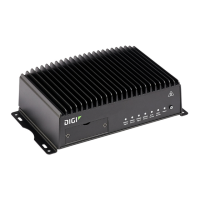Interfaces Wi-Fi interfaces
Digi TransPort WR Routers User Guide
37
Rx Compressed : 0 Tx Compressed : 0
Rx Multicasts : 0 Tx Collisions : 0
Rx Errors : 0 Tx Errors : 0
Rx Dropped : 0 Tx Dropped : 0
Rx FIFO Errors : 0 Tx FIFO Errors : 0
Rx CRC Errors : 0 Tx Aborted Errors : 0
Rx Frame Errors : 0 Tx Carrier Errors : 0
Rx Length Errors : 0 Tx Heartbeat Errors : 0
Rx Missed Errors : 0 Tx Window Errors : 0
Rx Over Errors : 0
Connected Clients
-----------------
MAC Address Connection Time RSSI Rate
-------------------------------------------------------
64:80:99:eb:72:d3 0h 2m 38s -75 dBm 81.0 Mbps
ec:9b:f3:bf:91:d2 0h 0m 20s -66 dBm 24.0 Mbps
digi.router>
Configure a Wi-Fi client and add client networks
Required configuration items
n Wi-Fi module mode
Configure the Wi-Fi module Mode as Client.
n Wi-Fi client networks
Add up to 16 client networks per router. For each client network:
SSID: Provide the SSID of the access point to which you want to connect.
Security: Provide the security type for the SSID. For personal security modes, you need to
enter only a password; for enterprise modes, you need to enter both the username and
password.
n WAN assignment
Once you configure a Wi-Fi client, you must assign the Wi-Fi client to a WAN. See Wide Area
Networks (WANs).
Additional configuration items
n Wi-Fi client: Using the command line only, you can configure custom values for RSSI thresholds
and other options. See wifi-client command.
n Wi-Fi client networks: Some access points hide (do not broadcast) their SSID. In this case,
enable the Hidden SSID option and the client will send out probes for the SSID when scanning.
In general, for both security and performance issues, Digi recommends you do not enable the
Hidden option.
See Interfaces—Wi-Fi page for a complete list of Wi-Fi interface configuration options.
Web
1. On the menu, click Network > Interfaces > Wi-Fi.

